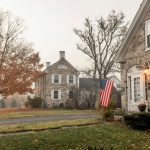Christmas lights twinkle in a greenhouse in Tiverton, Rhode Island. People haul unwieldy stacks of evergreens from car trunks and the backs of pickups and station wagons through the frosty night. The greenhouse at Manchester Tree & Landscaping pulsates with conviviality while pruning shears snap to the Supremes’
Christmas Collection. It is the night of the Lucy’s Hearth Wreath Workshop.
For the past few years, right around the first of December, the Little Compton/Tiverton contingent of the workshop has convened like clockwork. (Satellite workshops meet in the Rhode Island towns of Newport, Portsmouth, West Kingston, and Middletown.) The event is not advertised, but Daune Peckham, a local landscape designer, disseminates the date broadly by way of the botanical grapevine. By 5 o’clock on the prescribed evening, workstations are full and berried branches, pinecones, seedpods, holly branches, and rosehips are clipped, wired, and readied for wreath-ability. For the next few hours, the flash of florist wire threading between boughs punctuates the night. And gradually, a stack of creative, unique, and sometimes quirky holiday decorations mounts to be delivered to the Lucy’s Hearth Annual Designer Wreath Sale.
Founded 22 years ago, Lucy’s Hearth is a nonprofit organization providing shelter for homeless mothers and their children. This facility, situated in a former convent beside St. Lucy’s church in Middletown, houses women over the long haul, providing accommodations for months at a time — and often as long as a year or year and a half — while also offering classes in parenting and money management. Most nights, the shelter is filled to capacity.
The wreath sale, held at the Rotunda ballroom at Easton’s Beach in Newport, donates all proceeds to Lucy’s Hearth (last year’s sale netted $14,000 for the shelter), and it is for this good cause that so many volunteers donate their creative skills during the workshops. For most attendees, it’s just a night shift of what they’ve been doing all day. The Little Compton/Tiverton group is like a “Who’s Who” of wreath making, with Rick Peckham of Peckham’s Greenhouse (no relation to Daune) being the undisputed expert among a cognoscenti crowd. He’s the realist in residence, advocating “shake tests” and “drop tests” to ensure that the wreaths will weather the full brunt of occupational hazards — including gusting winds and rigorous door slammings — at their future homes.
For anyone who’s experiencing a wreath-making block, Rick willingly shares his formula: Use a mixture of different textures and subtly diverse colors. “It’s no different than making a perennial garden,” he says. Diversity ensures that you can see the trees in the forest, so to speak, in each evergreen composition. Coupling pointy pine with, say, complementary false cypress (
Chamaecyparis) plumes is an effective design strategy, but he cautions that it’s “better not to combine too many textures or colors.”
To enhance the palette, local landscapers have been saving their prunings especially for the event. Berries in particular are prime ingredients to add a colorful accent to evergreen compositions. But not everything works in wreaths — atlas cedar, for example, tends to drop needles after a few days, and accents such as sedum and dried hydrangea blossoms can also shatter prematurely. Several professional tricks are employed. For example, to keep laurel and broad-leaved evergreens prime, they’re sprayed with Wilt-Pruf. And, as a hard-and-fast rule, everything is wired in — so it will pass those crash tests. (The earmark of an expert wreath is that all the wire is hidden from sight.)
Thistles are a favorite of Rick’s (“it doesn’t matter that they hurt”), who endures the pain for art’s sake. And natural gleanings are only the beginning as far as ingredients are concerned — boas, crayons, feathers, seashells, and craft items are also part of the creative brew. With so many components available, Rick has noticed that a frequent lapse among wreath artists, while in the heat of pursuing a vision, is forgetting to leave space for a bow. And the bow on a wreath is like the halo on an angel. (It’s important, to say the least.) Because bow making is a skill that takes practice, Liz Peckham (Rick’s sister) is the designated bow maker and sends over sufficient ribbonry to supply everyone. “A little glitter,” Rick has found, “makes the bow stand out.”
Members of the Little Compton/Tiverton team come up with everything from topiaries, garlands, and swags to centerpieces and candle rings. Some turn out many pieces, while others focus on just a few stupendous creations. (Each group makes about 50 items in an evening, with a total of 250 to 300 wreaths and decorations being prepared for the sale.)
Ed Bowen, owner of Opus, a wholesale specialty plant nursery in Little Compton, brings a pickup load of prunings and traditionally spends the night laboring over two breathtaking oversize wreaths combining every texture and subtle shade of color imaginable in evergreens. The resulting masterpieces are always snatched up early and fetch a premium of $175. (Most items are priced between $35 and $85).
The creations get zanier as the hours of the workshop tick away. And sure enough, right before they wrap it up for the night, Daune gets out the boas and turns her hand to a pair of glitzy, glittery, over-the-top Elvis wreaths that always fly from the sales tables faster than you can say “Here Comes Santa Claus.”







